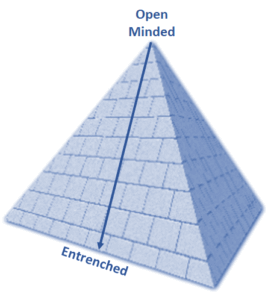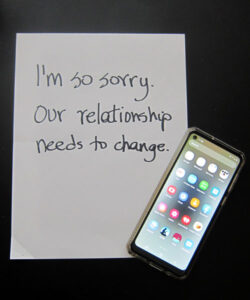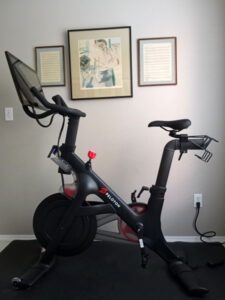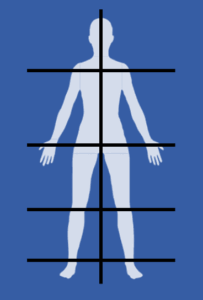Human beings have an “inner voice.” It’s the radio station to which our brains attune when not engaged actively in other matters. Its objects of attention are overwhelmingly me, myself, and I. When healthy, it provides a lot of useful services. For instance:
- It serves as a holding tank for information and helps us make sense of the world.
- It reflects on decisions we’ve made and how they impact our lives.
- It provides a means to control our baser instincts and emotions as a function of our upbringing and cultural conditioning.
- It reminisces about the past, considers alternate futures, and bends the imagination toward unlived lives.
- It keeps track of goals and encourages us to stay the course.
- It maintains a personal narrative that undergirds our sense of identity.
- It helps us discern our values and desires.
 In Chatter: The Voice in Our Head, Why It Matters, and How to Harness It, Dr. Ethan Kross suggests that this capability confers a survival advantage. We learn, change, and improve through self-reflection. We consider options before proceeding with a course of action. And we are alert to obstacles and dangers that could impede forward progress. Unfortunately, our inner dialogue can also devolve into a cyclical pattern of negative thoughts and emotions that impede performance, decision making, relationships, health, and happiness. For example:
In Chatter: The Voice in Our Head, Why It Matters, and How to Harness It, Dr. Ethan Kross suggests that this capability confers a survival advantage. We learn, change, and improve through self-reflection. We consider options before proceeding with a course of action. And we are alert to obstacles and dangers that could impede forward progress. Unfortunately, our inner dialogue can also devolve into a cyclical pattern of negative thoughts and emotions that impede performance, decision making, relationships, health, and happiness. For example:
“Who did I think I was taking on all of this responsibility? I’ll never be able to complete the project on time.”
“It has been 6 months since the accident, and I still can’t get over what happened. I keep reliving the experience over and over and thinking about what I should have done.”
“My boss is a real jerk. He never appreciates the time and effort that I put into each assignment. He doesn’t say a word when my work is picture perfect. He only comments when he finds a tiny mistake. I hate my job.”
When chatter hijacks our inner voice, Kross says “we zoom in close on something, inflaming our emotions to the exclusion of all the alternative ways of thinking about the issue that might cool us down.” This loss in perspective hogs neural capacity and interferes with normal executive functioning. We may falter in decision-making and wallow in paralysis by analysis. Automatic, learned skills on which we rely may break down. And the stress of it all may impact gene expression in a way that impacts our health.
Kross serves up several proven strategies to help us disrupt our ruminations and restore clarity of thought. They help us “zoom out” and put some distance between the thinker and the vexing thoughts so that a new conversation can take place. His recommendations:
- Change the subject in the inner dialog from the first person to the second or third person. Instead of “I feel anxious,” try “[Your Name] is feeling anxious” or “one feels anxious in this circumstance.” The alternate language instantly puts the inner voice into a totally different frame. Moreover, use of neutral subjects (“you” or “one”) normalizes the speaker’s experience – i.e., everyone feels that way sometimes. (“If they got through it, so can I!”) Kross reports that “distanced self-talk allows people to make better first impressions, improves performance on stressful problem-solving tasks, and facilitates wise reasoning.” Moreover, it’s a fast and highly effective life hack!
- Imagine that the circumstance is happening to a close friend. Talk to yourself as if you were comforting and advising that person.
- Consider looking at the scenario as if you were a fly on the wall and reporting findings to third parties. Acknowledge multiple viewpoints and see if you can reconcile opposing positions.
- Broaden your perspective. Rather than getting mired in the issue at hand, consider how this episode fits within the grand narrative of your life. Let it just be a moment that will pass.
- Reframe the experience as a challenge and not a threat. Remind yourself that you have the wherewithal to overcome obstacles. Narrate your body’s stress response as being in a high state of readiness for the task at hand.
- Do a little mental time travel. Consider how you’ll recall this episode in a year, 5 years, or 10 years. Again, let it just be a moment in time.
- Try journaling in the style of an investigative reporter. Write about the experience from the perspective of a dispassionate narrator.
- Use ritual to your advantage. A ritual can be any sequence of behaviors that are infused with meaning. You can draw from your cultural conditioning, or create ones specific to a habitual challenge. Rituals can clear the mind of useless chatter and help prepare for what comes next. Famous athletes leverage this tactic to ease tension, calm their nerves, and focus their attention.
If working from the inside out doesn’t float your boat, try working from the outside in. By creating order in your environment, you can increase your sense of control. Self-efficacy is a proven strategy to relieve anxiety. Alternatively, take a walk in nature. The sights, sounds, and smells of your surroundings captivates the mind and draws attention away from the nagging issue. The more awe-inspiring the vista, the greater the benefit. Stuck with an urban landscape? No worries. Breathless imagery and nature documentaries can do the trick.









